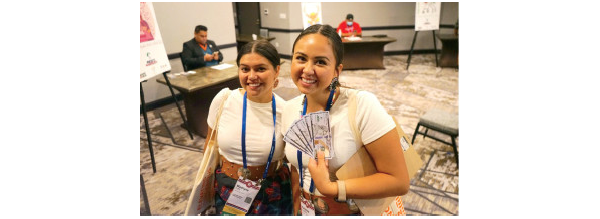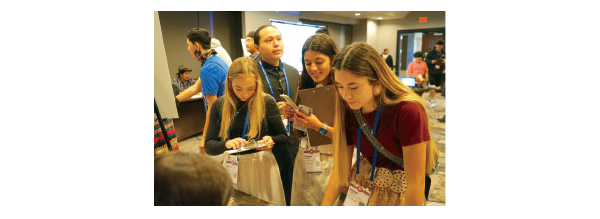AISES Adventure Real Life Simulation Activity
The Native Financial Cents AISES Adventure is a real-world money management simulation, designed for elementary, middle, and high school students and young adults by AISES. This activity offers Native youth the opportunity to practice handling money and to spend it wisely. AISES Adventure teaches important financial education concepts like budgeting, comparison shopping, and evaluating needs, wants, and tradeoffs in a relevant and engaging way.
In the simulation, students are given roles to play and fake money. Students have to make informed spending decisions to purchase a car, get housing, groceries, taxes, student loans, etc.
Students can practice visiting a bank to cash their check and deposit a share of their money into savings and are also given the opportunity to learn about investing a portion of their money.
Students can establish good money handling practices when visiting the local casino or bingo hall.
AISES Adventure kits are available to all participants (1 per school/group).

AISES ADVENTURE
Preliminary Work:
The AISES Adventure consists of 13 stations that represent different financial aspects of budgeting and spending. These stations are:
1. BlackHawk Bank
2. Big Horn Charity & Tax Services
3. Tradish Housing and Utilities
4. Black Hills Medical Services
5. Monument Valley Transportation
6. Black Buffalo Grocers
7. Grandma’s Childcare
8. DeerInWater Department Store
9. Coyote Furniture Gallery
10. Poolaw Personal Care (Rezzy Cuts)
11. Vermillion Entertainment<
12. EchoHawk Casino & Resort
13. Tall Oak Trading Post
You will need at least 15 volunteers to manage each station in a room large enough for students to move from station to station easily. The Tradish Housing and Utilities will need 2 volunteers (1 for housing and 1 for utilities). The Vermillion Entertainment will need 2 volunteers (1 for entertainment and 1 for eating out) Set up room with 13 tables/stations. At each station, put a station sign, Station Instructions, writing utensils, calculator, and money. Students may need a clipboard to write on. One volunteer will be in charge of the “Chance Cards.”
The minimum amount of time for the AISES Adventure is one hour. Plan for the first 10 minutes for introduction, 40 minutes for the students to visit the stations, and the final 10 minutes for debriefing.
Activity:
See the “Detailed Script” in the Supplemental Materials section
Use the definitions and talking points below to explain the AISES Adventure to participants:
- Each of you will be receiving a Profile and Budget Worksheet that includes career, income, and family information. You will use the information on the profile to make some “real world “financial decisions. As you look around the room you will notice we have 13 stations that mimic financial obligations you may encounter in real life. During this experience you will have to go to — and make a decision at — each station. You can go in any order you would like, but your first stop is the Bank!
- The income on your profile includes important information you will use throughout the activity:
- Gross Salary: the amount of money you make before any taxes or other deductions are taken out of your pay check.
- Take home pay: the amount of money you get to keep from your paycheck after all taxes and deductions.
- If you are married, you will see a box on the right side of your profile that tells you the profession of your spouse and the amount of their monthly take home pay.
- Additionally, on your profile you will see how much you are contributing to your retirement, your level of education, if you have a student loan payment, and if you have any children. These will all be key points of information you will need to reference during the AISES Adventure. [Be sure students are following along – to check for understanding you may want them to raise their hand to indicate whether they are married, single, or have a student loan.]
- Under the “Station” column we have provided a retirement field and calculated your new balance for you. Next, we have provided a student loan field. Use the math shown in the retirement row as a guide to calculate your new balance after subtracting student loans. If you don’t have any student loans, you don’t have this expense so your monthly balance will remain the same. For example, you will need to consider family size before selecting a car or home.
- As you enter the AISES Adventure, continue this process. Remember to refer back to your profile as you go through this experience. Some stations will have different costs based on your family size.

- Depending on the size of your group, estimate 30 - 40 minutes for students to visit each of the stations. After 20 minutes (or so), remind participants that they must visit all of the stations, except childcare if the profile does not include a child/children. They don't need to visit the casino or pawn shop. If there are too many participants at one station encourage them to visit one of the others.
- Walk around and assess understanding and/or help with challenges.
- When participants finish, invite them to sit down and discuss the experience with a partner. You may also want them to review the Budgeting Tips article if you have already distributed it.
- Once all participants are finished and have returned to their seats, use these discussion questions to guide your debrief and reinforce lessons taught in the AISES Adventure:
- What reactions do you have to this simulation?
- What lessons did you learn from this activity?
- What considerations were important as you visited each station?
- Does anyone want to share your strategy – whether you thought it was successful or not?
- By raising your hands, who had money left over? Who ran out of money?
- Did you return to any station and change your decision? Which one? Why?
- Which station was the most challenging? The easiest?
- By raising your hands, who received a chance card that added money to your budget? How did that make you feel?
- Of those that had unexpected expenses, how did you handle the situation?
- Based on what you learned, what might you do differently in your real life?
- After your discussion, pass out the student evaluations
- Collect the completed evaluations.
- Gather all station materials and store them for reuse.

